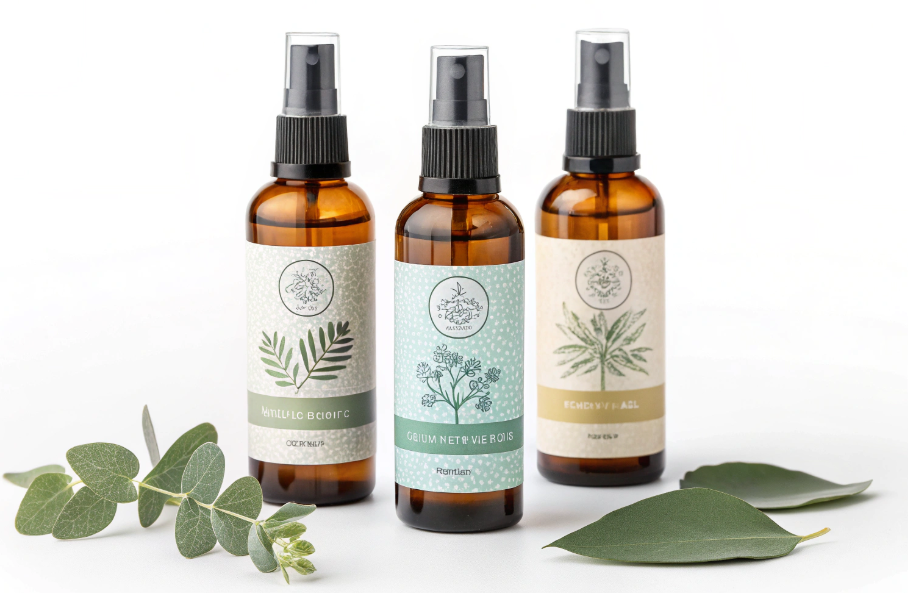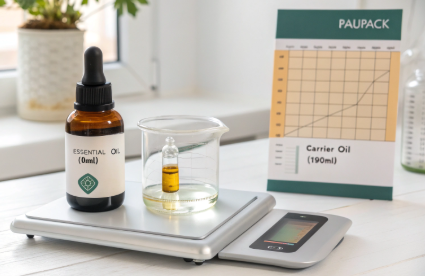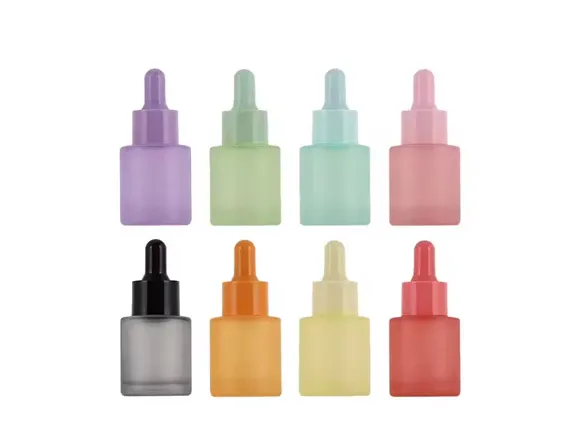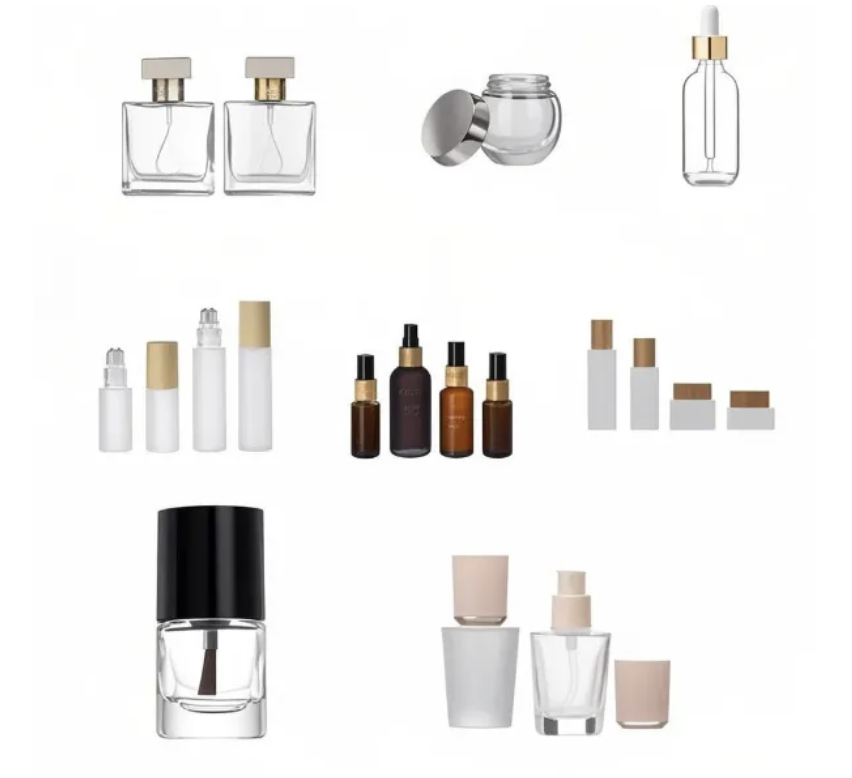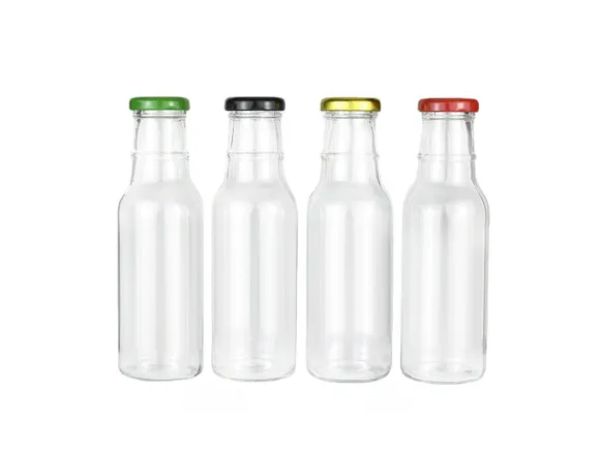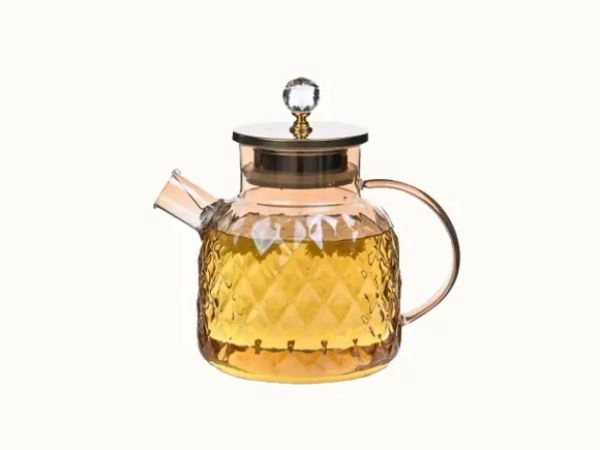When working with a small batch, precision matters. Overdosing essential oils in a 10ml roller bottle or dropper can make your product too strong—or even unsafe.
For a 1% dilution, use 2 drops of essential oil in 10ml of carrier oil. For stronger blends like massage oils (2–3%), you can use 4–6 drops.
Here’s a quick chart:
Essential Oil Drops per 10ml Carrier Oil
| Dilution % | Drops (approx.) | Use Case |
|---|---|---|
| 0.5% | 1 | Infants, sensitive skin |
| 1% | 2 | Daily skincare, face oils |
| 2% | 4 | Body oils, lotions |
| 3% | 6 | Massage blends |
| 5% | 10 | Spot treatments, roller perfumes |
| 10% | 20 | Strong aromatherapy, caution advised |
Converting Between Milliliters, Ounces, Teaspoons, and Drops
If you ever find yourself needing to switch between milliliters, ounces, teaspoons, or drops when measuring essential oils, you’re not alone. Many DIYers and small-batch makers run into this question—especially with recipes and bottles arriving from different parts of the world.
Here’s a conversion reference to keep things practical:
- 1 ml= 0.034 oz = 1/5 tsp ≈ 20–30 drops (depending on oil viscosity and dropper)
- 2 ml= 0.068 oz = 2/5 tsp ≈ 40–60 drops
- 5 ml= 0.17 oz = 1 tsp ≈ 100–150 drops
- 10 ml= 0.34 oz = 2 tsp ≈ 200–300 drops
- 15 ml= 0.51 oz = 3 tsp (or 1 Tbsp) ≈ 300–450 drops
- 30 ml= 1.01 oz = 6 tsp (2 Tbsp) ≈ 600–900 drops
- 60 ml= 2.03 oz = 12 tsp (4 Tbsp) ≈ 1,200–1,800 drops
- 120 ml= 4.06 oz = 24 tsp (8 Tbsp) ≈ 2,400–3,600 drops
Helpful tip:These numbers are based on averages. Actual drop count can vary by the essential oil type and dropper tip, but they work well for general blending, diluting, or scaling recipes from Pinterest or your favorite aromatherapy book.
Keep this chart handy when you’re moving from recipes inAmericancookbooks (with ounces and teaspoons) toEuropeanor international guides (milliliters). It will save you both time and guesswork—leaving more time for experimenting with new blends and less for double-checking conversions.
How Viscosity Impacts Drop Count
It's easy to assume that each milliliter of essential oil will always equal the same number of drops—but that's not quite the case. The thickness, or viscosity, of the oil plays a surprisingly important role.
Lighter oils, such as citrus (think lemon or orange), tend to flow more freely and produce smaller drops. So, a single milliliter might yield more drops. On the other hand, thicker oils—like vetiver or patchouli—drip out more slowly and form larger drops, reducing the total per milliliter.
A few factors that influence this include:
- Consistency of the Oil:Thin oils = more drops per milliliter; thick oils = fewer drops.
- Dropper Design:Some droppers are made for thin fluids, others for thick, which adds another layer of variability.
- Temperature:Warmer oils flow faster and create smaller drops, especially with higher-viscosity blends.
With these variables, expect anywhere from 20–40 drops in a single milliliter—often on the lower end for thicker essential oils and higher for the lighter ones. Always keep this variability in mind when blending or following recipes, especially for small batches where precision really counts.
Are All Essential Oil Drops the Same Size?
Not quite! The size of each drop isn't always identical. It actually depends on two main things:
- Viscosity of the oil:Thicker oils (think vetiver or sandalwood) tend to form bigger, slower drops than lighter oils like lavender or tea tree.
- Dropper style:The shape and size of the bottle’s dropper or orifice reducer can change how large or small each drop ends up.
For this reason, counting drops gives you a close estimate, but it isn’t 100% precise every time. If absolute accuracy matters—for example, in skincare or aromatherapy blends—it’s a good idea to measure by milliliters or use a pipette for consistent results.
What factors influence the drop count in essential oil bottles?
If you've ever noticed that ten drops from one essential oil bottle seem bigger—or smaller—than ten drops from another, you’re not imagining things. Several factors come into play:
- Type of Dropper:Standard euro droppers, pipettes, and syringe applicators all release different drop sizes. Even among glass droppers, some are designed for thicker oils, resulting in chunkier drops.
- Viscosity of the Oil:Essential oils range from thin and watery (like citrus oils) to rich and syrupy (think vetiver or patchouli). Thicker oils drip slower and form larger drops.
- Bottle Size and Opening:The diameter of the orifice reducer or the dropper tip can make each drop larger or smaller.
- Temperature and Humidity:Warmer temperatures can make oils runnier, leading to smaller drops, while cooler conditions may make the oil thicker, increasing drop size.
So, if you’re blending at home, don’t be surprised if your dropper delivers a slightly different result compared to industry standards or recipes online. When in doubt—or if precision really matters—measure by volume using a graduated cylinder or syringe for best results.
Why Dropper Size and Design Matter
When it comes to dispensing essential oils, the dropper isn’t just a tool—it’s an important factor in your results. The number of drops in your blend can vary quite a bit depending on the dropper’s size, shape, and style.
A thinner dropper tip releases smaller drops, while wider tips yield larger drops. The material and channel size also play their part—droppers fromAura Cacia,Now Foods, orRocky Mountain Oilscan all behave differently. Even the cut or “shoulder” of the dropper inside the bottle influences the flow.
Why does this matter? When you’re following a recipe calling for “X drops,” the actual volume per drop can differ between droppers. That’s why precision can be tricky unless you stick to the same bottle and dropper each time. If consistency is crucial (like for skincare formulas), consider measuring by volume (milliliters) for more reliable results.
Common Misconceptions About Counting Drops in Essential Oil Bottles
While measuring in drops seems straightforward, there are a few pitfalls to watch for:
- Not all drops are created equal.The size of a drop can change depending on the viscosity of the oil, your dropper’s design, and even the temperature of the room. A drop of lavender oil from a Euro dropper can be very different from a drop of thick vetiver from a glass pipette.
- Comparing liquids can be misleading.A milliliter of essential oil will not produce the same number of drops as a milliliter of water or milk. Essential oils can be heavier or lighter, so drop count isn’t universal.
- Droppers matter.The kind of dropper you’re using—bulb pipette, reducer cap, or orifice reducer—directly affects your droplet size. That means every bottle and brand (thinkNow FoodsversusPlant Therapy) can give slightly different results.
- Counting drops isn’t always precise.If you’re making a blend where accuracy really matters—like for children’s products or facial serums—it’s wise to measure in milliliters or use a syringe for the most predictable results.
Keeping these quirks in mind will help ensure your blends are safe, effective, and as close to the recommended dilution as possible.
Are all droppers (including eyedroppers) the same for dispensing essential oils?
Not quite. While droppers might look similar, they're not universally equal—especially when measuring essential oils. Eyedroppers, for example, are made with medical use in mind and may dispense bigger or smaller drops than droppers designed specifically for essential oils (think the ones from brands likeAura CaciaorNow Foods). This can throw off your measurements if you're aiming for precision.
For the most reliable results in blending, always use the same dropper type for both measuring and dispensing. If you swap between droppers, even a 1% dilution can become too strong—or too weak—depending on the drop size. Consistency is key to safe and effective blends.
What is the best ratio of carrier oil to essential oil?
The "best" ratio depends entirely on the product's purpose—what works for an adult massage oil would be too strong for facial skincare or children.
The most commonly used essential oil to carrier oil ratio is 1–2%, which translates to 1–2ml of EO per 100ml of carrier oil—or about 20–40 drops.
Here’s how to think about it:
-
1%: Safe for face, kids, and daily use
-
2%: Great for lotions or body oil
-
3–5%: Use for short-term therapeutic blends
-
10%+: Reserved for perfumes or very targeted application
PauPack’s dropper and spray bottles are optimized for a variety of viscosities—whether you’re using jojoba, almond oil, or fractionated coconut as a base.
Why Dropper Design and Oil Consistency Matter
Before you even start counting drops, there’s a detail that often gets skipped: the dropper itself.
Just like a kitchen scale varies by brand, not all droppers measure out the same. The opening’s width, length of the tube, and even the material can all impact how many drops you get per milliliter. For example, a fine-tip dropper fromEden’s Gardenmight give you smaller, more precise drops, whereas a bulkier version fromNOW Foodscan deliver larger ones. This variation means your “10 drops” may look quite different from someone else’s.
Then there’s the oil. Essential oils aren’t all created equal in texture—some, like lemon or eucalyptus, pour easily and quickly. Others, such as sandalwood or patchouli, are thick and slow. The thicker the oil, the slower it drips, sometimes giving you fewer drops per ml than a thinner oil.
If you’re aiming for accurate blends, consider both dropper style and oil consistency. A little testing with your chosen dropper and oil type goes a long way. The goal? Consistency in your recipes, from bottle to bottle.

What is the 30 50 20 rule for essential oils?
Blending essential oils isn’t just about safety—it’s also about scent structure. That’s where the 30-50-20 rule comes in.
The 30-50-20 rule is a fragrance-blending guideline: 30% top notes, 50% middle notes, and 20% base notes. It helps build a layered, balanced aroma.
| Note | Role | Examples |
|---|---|---|
| Top (30%) | First impression | Lemon, Peppermint, Bergamot |
| Middle (50%) | Heart of the blend | Lavender, Geranium, Chamomile |
| Base (20%) | Lasting effect | Sandalwood, Patchouli, Cedarwood |
When formulating for retail, keeping this rule in mind helps you create products that not only feel great—but smell incredible too. PauPack helps brands pair their blends with premium packaging that reinforces luxury through scent layering.
How much essential oil for a 10ml bottle?
If you’re filling a 10ml bottle—say a roll-on or dropper—you’ll need to consider your target dilution.
Use 1–2% dilution for skincare (2–4 drops), and up to 5% (10 drops) for stronger, short-term use. Never fill 10ml bottles with pure essential oil for direct skin use.
Here’s a usage scenario:
Sample Blend for 10ml Roll-On Bottle
-
Carrier Oil: 9.8ml fractionated coconut oil
-
Essential Oils:
-
3 drops lavender (middle note)
-
1 drop peppermint (top note)
-
1 drop frankincense (base note)
-
= 5% total dilution (5 drops EO in 10ml)
At PauPack, our roller bottles come pre-measured and leak-proof—perfect for on-the-go aromatherapy and easy formulation scaling.
Conclusion
To mix 10ml of essential oil safely, you’ll need at least 190ml of carrier oil for a 5% blend—or more for milder use. Always tailor your ratio based on skin type, product purpose, and application method.




